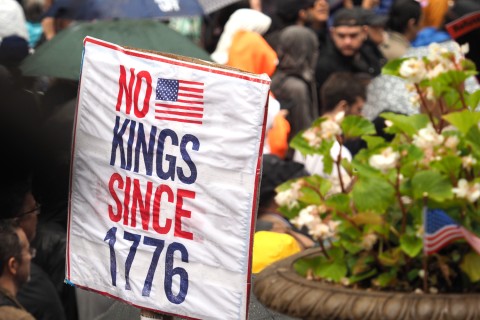A review of God of Liberty
Students of American religious history have long been aware that, at least until recently, the field has been riddled with four yawning gaps—eras that cried out for solid synthetic treatments. Those gaps are (in reverse chronological order) religion during the Great Depression, religion and the Civil War, religion during the Revolutionary era and religion during the Great Awakening. Religion in the Great Depression still awaits its historian, while Harry Stout's magisterial 2006 volume, Upon the Altar of the Nation, analyzes the discordant religious voices during the Civil War. A comprehensive understanding of the Great Awakening of the 1730s and 1740s had eluded historians—well, forever; Edwin Gaustad tried valiantly a generation ago, but his efforts were confined to New England and neglected the other colonies.
Along comes Thomas S. Kidd, associate professor of history at Baylor University, who now has slain two of these historiographical dragons. His 2007 book, The Great Awakening: The Roots of Evangelical Christianity in Colonial America, demonstrates that the real contest in mid-18th-century America was not between New Lights and Old Lights (proponents and opponents of the revival) but between moderate and radical evangelicals. Now, with the publication of God of Liberty: A Religious History of the American Revolution, Kidd has admirably filled a second major gap in our understanding of American religious history.
Read our latest issue or browse back issues.
That task was not simple. Well over half a century ago, Perry Miller, who had rediscovered the Puritans in the 1930s, suggested that there was a connection between the evangelicalism of the Great Awakening and the Patriot cause of the American Revolution. One of Miller's students, Alan Heimert, took on the challenge of making that link, famously reading "beyond the lines" of evangelical and Patriot rhetoric to produce, in 1966, Religion and the American Mind: From the Great Awakening to the Revolution. When I was studying colonial history in graduate school in the early 1980s, Religion and the American Mind, which had been savaged in the reviews, was held up as a paradigm of historical overreaching. Heimert, focusing almost entirely on published sources, had forced the connection and taken liberties with his sources in order to argue that there was an almost seamless path from revival to Revolution.
God of Liberty suffers from no such overreaching. With impressive command of the primary sources and deft historical analysis, Kidd has produced an indispensable survey of religious life during the Revolutionary era. (Certainly the irony cannot have been lost on Kidd that his editor for God of Liberty, the incomparable Lara Heimert, is Alan Heimert's daughter.)
Kidd demonstrates that the revivalism of the Great Awakening became politicized during the Seven Years' War, which "forged a visceral bond among Protestantism, anti-Catholicism, and liberty." Apocalyptic imagery abounded, with Catholicism identified with both the Antichrist and monarchy. The Stamp Act of 1765 implicated the British crown in that web of arbitrary and malevolent power and set the stage for the American Revolution.
During the Revolution itself, evangelicals generally lined up with the Patriots. After preaching on Ecclesiastes 3 ("To every thing there is a season") in January 1776, Peter Muhlenberg of Woodstock, Virginia, stepped down from his pulpit and removed his vestments to reveal a military uniform, announcing that he had accepted a commission with a Virginia regiment. Three hundred members of his congregation signed up for the army that day.
Military chaplains were viewed as crucial to the success of the Continental Army. Americans had been scandalized by the vulgarity of British soldiers, and they came to believe that "success in the war depended on their individual moral character and that of their new nation." Chaplains monitored the behavior of soldiers, fearing that moral lapses would throw the Patriot cause off course. The British surrender at Yorktown was greeted as evidence of divine favor. Kidd does point out the "morally problematic" nature of American providentialism, as demonstrated by the clergy's endorsement of the destruction of Iroquois towns during the war.
Roiling beneath the surface during these years was growing evangelical discontent about religious establishments, which came to be seen as another species of coercion and an affront to liberty. Kidd expertly reviews the relations between church and state in the various colonies and charts the progress toward disestablishment. "Even before the advent of the American Revolution," the author writes, "the stage had been set for the cooperation of evangelicals and more liberal Christians, not only in the Patriot cause but also in the struggle to disestablish the state churches."
On the national level, Kidd sees the common ground between Thomas Jefferson and Baptist preacher John Leland as emblematic of the emerging synergy between religion and politics. The two men could not have been more different—one was an Enlightenment rationalist and the other an evangelical itinerant preacher—but they forged both an enduring friendship and a crucial alliance to sever the connection between church and state.
God of Liberty is all the more remarkable for its breadth, spanning the Atlantic seaboard all the way into Canada, as well as the decades from the Great Awakening to Jefferson's victory over John Adams in the presidential election of 1800, which Kidd believes brings the Revolutionary era to an end with the peaceful transfer of presidential power from the Federalists to the Democratic-Republicans. Despite the hyperventilation of some religious types during the 1800 campaign, Jefferson's election did not signal the end of faith. By then the First Amendment was already working its magic, ensuring both the free exercise of religion and government neutrality in religious matters, rendering laughable even Jefferson's own late-in-life prediction that something like Unitarianism would eventually become the dominant religion of the nation.
One of the many virtues of this book is that Kidd is a careful and judicious historian, loath to draw parallels to current issues. In the appendix, however, he points out—correctly—the errors of both present-day secularists on the left, who insist that the founders barred religious voices from political discourse, and the church-state separation deniers on the right. The lesson of American history is that although church and state are institutionally separate, morality and freedom are seldom at odds and that, in fact, they are mutually reinforcing. As was the case during the Revolution itself, Kidd concludes, "it is still difficult to imagine a better source than religion for channeling American freedom toward benevolent ends."







